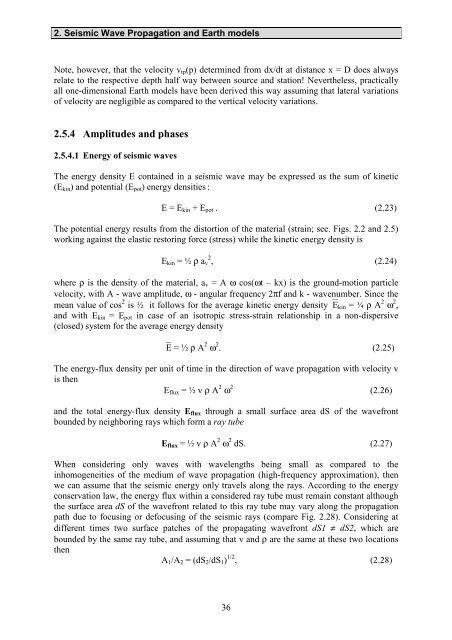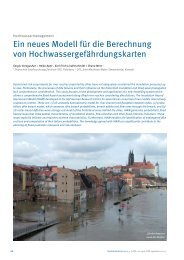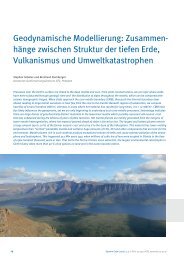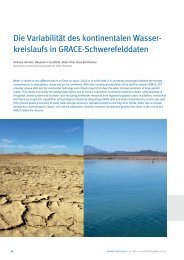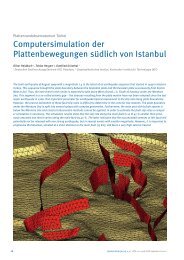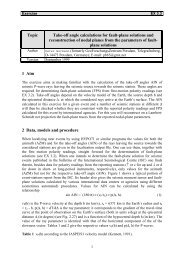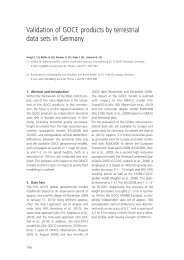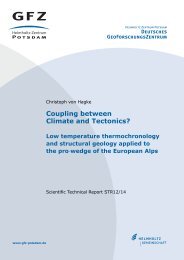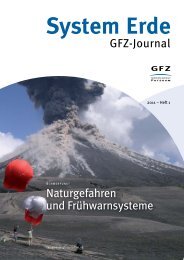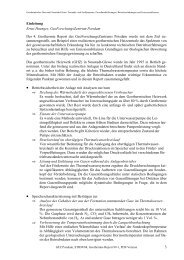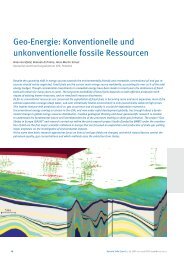2 Seismic Wave Propagation and Earth models
2 Seismic Wave Propagation and Earth models
2 Seismic Wave Propagation and Earth models
Create successful ePaper yourself
Turn your PDF publications into a flip-book with our unique Google optimized e-Paper software.
2. <strong>Seismic</strong> <strong>Wave</strong> <strong>Propagation</strong> <strong>and</strong> <strong>Earth</strong> <strong>models</strong><br />
Note, however, that the velocity vtp(p) determined from dx/dt at distance x = D does always<br />
relate to the respective depth half way between source <strong>and</strong> station! Nevertheless, practically<br />
all one-dimensional <strong>Earth</strong> <strong>models</strong> have been derived this way assuming that lateral variations<br />
of velocity are negligible as compared to the vertical velocity variations.<br />
2.5.4 Amplitudes <strong>and</strong> phases<br />
2.5.4.1 Energy of seismic waves<br />
The energy density E contained in a seismic wave may be expressed as the sum of kinetic<br />
(Ekin) <strong>and</strong> potential (Epot) energy densities :<br />
E = Ekin + Epot . (2.23)<br />
The potential energy results from the distortion of the material (strain; see. Figs. 2.2 <strong>and</strong> 2.5)<br />
working against the elastic restoring force (stress) while the kinetic energy density is<br />
Ekin = ½ ρ av 2 , (2.24)<br />
where ρ is the density of the material, av = A ω cos(ωt – kx) is the ground-motion particle<br />
velocity, with A - wave amplitude, ω - angular frequency 2πf <strong>and</strong> k - wavenumber. Since the<br />
mean value of cos 2 is ½ it follows for the average kinetic energy density⎺Ekin = ¼ ρ A 2 ω 2 ,<br />
<strong>and</strong> with Ekin = Epot in case of an isotropic stress-strain relationship in a non-dispersive<br />
(closed) system for the average energy density<br />
⎺E = ½ ρ A 2 ω 2 . (2.25)<br />
The energy-flux density per unit of time in the direction of wave propagation with velocity v<br />
is then<br />
Eflux = ½ v ρ A 2 ω 2 (2.26)<br />
<strong>and</strong> the total energy-flux density Eflux through a small surface area dS of the wavefront<br />
bounded by neighboring rays which form a ray tube<br />
Eflux = ½ v ρ A 2 ω 2 dS. (2.27)<br />
When considering only waves with wavelengths being small as compared to the<br />
inhomogeneities of the medium of wave propagation (high-frequency approximation), then<br />
we can assume that the seismic energy only travels along the rays. According to the energy<br />
conservation law, the energy flux within a considered ray tube must remain constant although<br />
the surface area dS of the wavefront related to this ray tube may vary along the propagation<br />
path due to focusing or defocusing of the seismic rays (compare Fig. 2.28). Considering at<br />
different times two surface patches of the propagating wavefront dS1 ≠ dS2, which are<br />
bounded by the same ray tube, <strong>and</strong> assuming that v <strong>and</strong> ρ are the same at these two locations<br />
then<br />
A1/A2 = (dS2/dS1) 1/2 , (2.28)<br />
36


